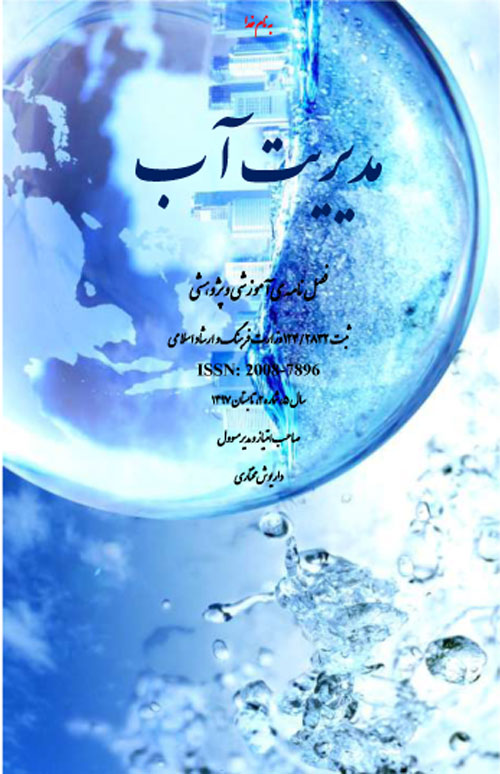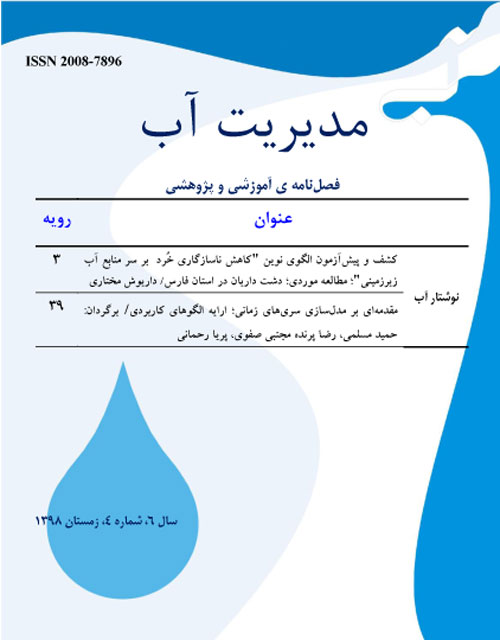فهرست مطالب

نشریه مدیریت آب
سال پنجم شماره 2 (پیاپی 13، تابستان 1397)
- تاریخ انتشار: 1397/06/13
- تعداد عناوین: 3
- نوشتار آب
-
صفحات 3-28
مناطقی مانند خاورمیانه و شمال آفریقا و آسیای مرکزی به طور جدی دچار مشکل کمبود آب و بارش های جوی هستند. این نوشتار به بحران آب در ایران می پردازد و وضعیت موجود، مشکلات و پیامدهای آن را مورد بررسی قرار می دهد. نتایج این بررسی که با کمک مطالعات کتابخانه ای انجام گرفته است، نشان می دهد که می توان بحران آب در ایران را به دو بخش اقلیمی و حکمرانی (مدیریتی) تقسیم کرد. در بخش اقلیمی مساله مهم این است که ایران در قسمت خشک و نیمه خشک جهان قرار دارد و نزولات جوی بسیار کمتر از میانگین جهانی است. البته این میزان با توجه به تغییرات آب و هوایی کاهش یافته و دوره های خشکسالی نیز دلیل مضاعفی بر شدت یافتن بحران شده است. در بخش حکمرانی نیز بهره وری بسیار پایین در مصارف کشاورزی، استفاده بی رویه آب برای مصارف خانگی، مکان یابی نامناسب صنایع آب بر، صادرات آب مجازی، برداشت بیش از حد از ذخایر زیرزمینی و اجرای پروژه های انتقال آب در داخل کشور وجود دارد که وضعیت نامناسبی را ایجاد کرده که منازعات استانی و قومی بر سر آب، از بین رفتن کشاورزی در برخی مناطق و خشک شدن رودخانه ها و دریاچه ها از پیامدهای آن است.
کلیدواژگان: بحران آب، ایران، منازعات آبی -
صفحات 29-60
بیشتر در این بررسی، عوامل ایجادکننده بحران آب در ایران شامل افزایش جمعیت، مهاجرت و توزیع نامساوی جمعیت، وقوع خشکسالی، تکیه زیاد بر اقتصاد کشاورزی و مدیریت نامناسب می باشد. همچنین چالش های طولانی مدت ناشی از بحران آب شامل سهم مصرفی از کل منابع آب شیرین قابل تجدید، افت دسترسی به سرانه آب تجدیدپذیر، کیفیت آب، کاهش سطح آب در سفره های زیرزمینی، بلایای طبیعی، فاصله بین عرضه و تقاضا، افزایش پروژه های ناتمام، هدرروی آب و عدم کارایی سامانه آبیاری، رقابت کاربران و جنگ آب و تخریب زیست محیطی می باشد. در پایان بر پایه یافته ها، نتایج و پیشنهادات سیاستی ارایه شده است.
کلیدواژگان: ایران، بحران آب، پیامدها، سیاست ها
-
Pages 3-28
Areas like the Middle East and North Africa and Central Asia are seriously affected by water scarcity and precipitation. This article deals with the water crisis in Iran and examines the current situation, its problems and consequences. The results of this study, conducted with help of library studies, show that the water crisis in Iran can be divided into climatic and governance sectors. The climate part, the important problem is that Iran is located in the arid and semiarid part of the world and its precipitation is much lower than the global average. However, this has been reduced due to climate change and droughts have added to the crisis. The governance part, also has very low agricultural productivity, excessive use of water for home use, inappropriate location of water industries, virtual water exports, over-exploitation of underground reserves and implementation of transmission projects In country, that has created an inadequate situation and ethnic disputes over water, the loss of agriculture in some areas, and the drying up of rivers and lakes are consequences.
Keywords: Water crisis, Iran, Water disputes -
Pages 29-60
Most in this study, the factors causing the water crisis in Iran include population growth, migration and unequal distribution of population, occurrence of drought, high reliance on agricultural economy and inadequate management. The long-term challenges due to water crisis include: the share of total renewable freshwater resources, loss of access to renewable water per capita, water quality, groundwater depletion, natural disasters, the gap between supply and demand, increasing uncompleted projects, Water waste and irrigation system inefficiencies, user competition and water wars and environmental degradation. Finally, the findings, policy conclusions and recommendations are presented.
Keywords: Iran, Water crisis, Consequences, Policies -
Pages 61-76
Urbanization has been one of the challenges of the present century that have consequence including its effects on reducing the amount of surface runoff to the ground and the occurrence of urban floods. Contamination of these runoffs to variety of elements in urban environments is also a problem that with low levels of surface runoff which makes it difficult to direct applied them for other purposes. Today, one of the best ways to reduce the volume and pollution of surface runoff is the use of best management practices (BMPs) that have been the focus of most cities around the world. In the present paper, the effects of some of these strategies, including garden-canal and permeable pavement, on reducing runoff contamination in the study area, which is part of Tehran Municipality 10, It has been studied using surface runoff management software. Different scenarios have been considered for using these management strategies. In all cases, the results show that the efficiency and effectiveness of using these two types of BMPs have been in reducing the volume and peak runoff and runoff contamination. The results showed that the permeable pavement had a better performance in reducing the peak and elimination of pollution in the studied area and the best option in most scenarios was the combination of garden-canal and permeable pavement practices.
Keywords: Best Management Practices, Urban Floods, Quantity, Quality of Runoff


